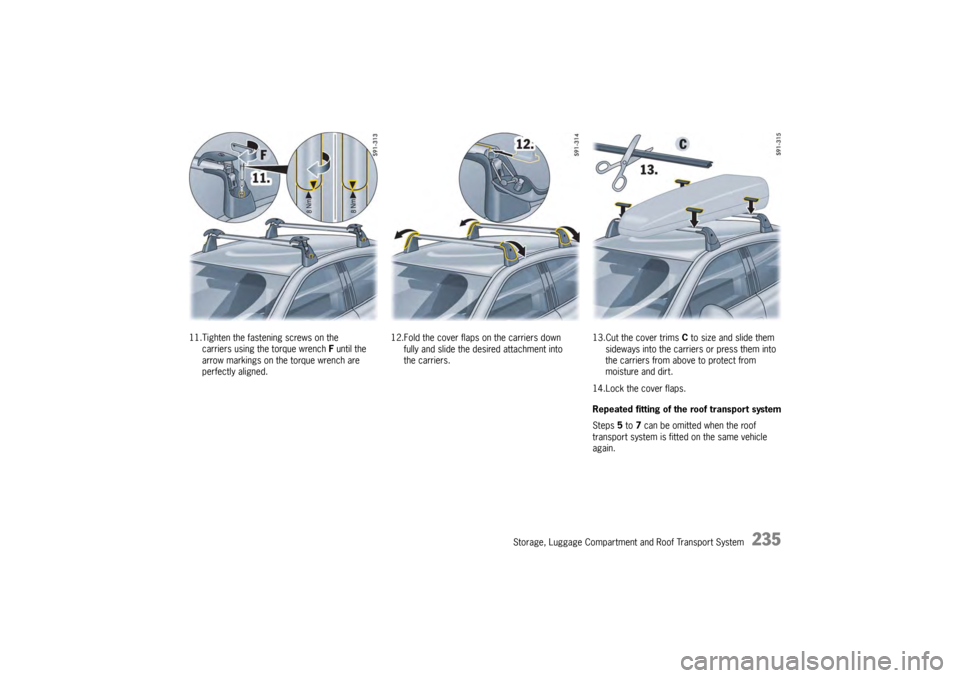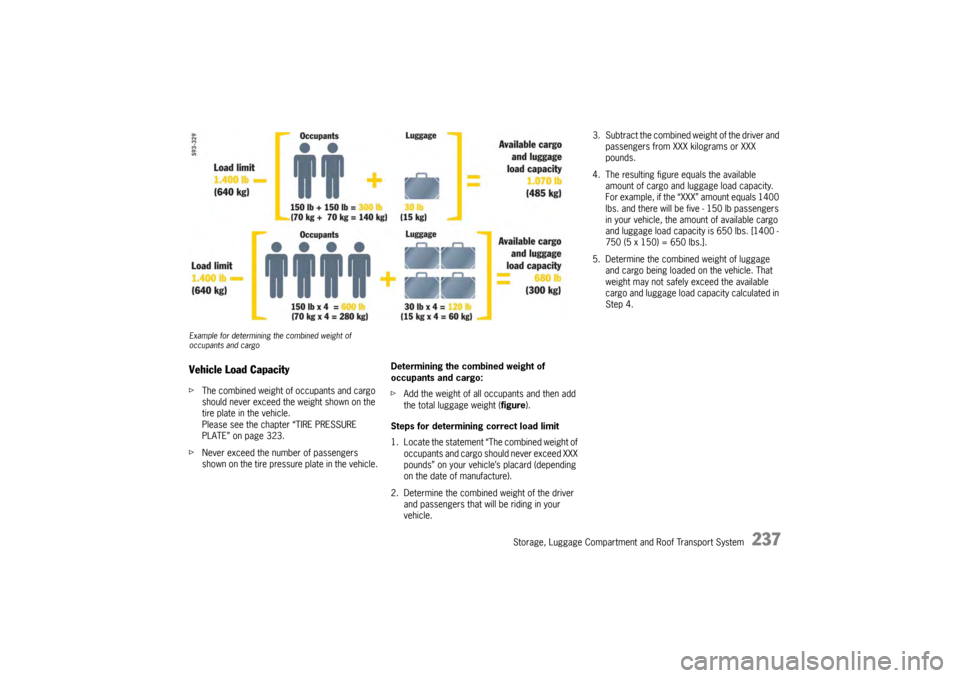2009 PORSCHE PANAMERA roof
[x] Cancel search: roofPage 237 of 343

Storage, Luggage Compartment and Roof Transport System
235
11.Tighten the fastening screws on the
carriers using the torque wrench F until the
arrow markings on the torque wrench are
perfectly aligned. 12.Fold the cover flaps on the carriers down
fully and slide the desired attachment into
the carriers. 13.Cut the cover trims
C to size and slide them
sideways into the carriers or press them into
the carriers from above to protect from
moisture and dirt.
14.Lock the cover flaps.
Repeated fitting of the roof transport system
Steps 5 to 7 can be omitted when the roof
transport system is fitted on the same vehicle
again.
Page 238 of 343

236
Storage, Luggage Compartment and Roof Transport System
Loading InformationDefinitionsThe rear-axle load is the vehicle weight on the
rear axle plus the weight of the transported load.
The Curb weight - actual weight of your vehicle -
vehicle weight including standard and optional
equipment, fluids, and emergency tools. This
weight does not include passengers and cargo.
The Gross Vehicle Weight is the sum of the curb
weight and the weight of passengers and cargo
combined.
The Gross Vehicle Weight Rating is the
maximum total weight of vehicle, passengers,
luggage, hitch, trailer tongue load and optional
equipment.
The Gross Axle Weight Rating is the maximum
load limit for the front or the rear axle. This
information is located on the safety comliance
sticker located in the dr iver’s side door jamb.
For determining the compat ibility of the tire and
vehicle load capabilities:
f Please see the chapter “TIRES AND WHEELS”
on page 280. The load capacity coefficient (e.g. “106”) is a
minimum requirement. For more information:
f
Please see the chapter “INSCRIPTION ON
RADIAL TIRE” on page 288.
The Gross Combined Weight Rating is the
maximum total weight rating of vehicle,
passengers and cargo.
The Vehicle Capacity Weight - Load Limit - is
the maximum total weight limit specified of the
load (passengers and cargo) for the vehicle. This
is the maximum weight of passengers and cargo
that can be loaded into the vehicle. This infor-
mation can be found on the tire pressure plate.
The maximum loaded vehicle weight is the
sum of curb weight, acce ssory weight, vehicle
capacity weight and production options weight.
The load rating is the maximum load that a tire
is rated to carry for a given inflation pressure.
The maximum load rating is the load rating for
a tire at the maximum permissible inflation
pressure.
The cargo capacity is the permissible weight of
cargo, the subtracted weight of passengers from
the load limit.
f Never exceed the permissible limits.
Danger!
Risk of personal injury or death.
Injuries are much more likely in an accident
if persons ride in the cargo area.
f Persons must ride only on the seats provided
for this purpose.
f Make sure that everybody fastens their safety
belts.
Risk of loss of control, damage to the vehicle
and serious personal injury or death.
f Never exceed the specified axle loads.
Overloading can shorten the service life of the
tires and car, as well as lead to dangerous
vehicle reactions and long braking distances.
Damage due to overloading is not covered by the vehicle warranty.
Page 239 of 343

Storage, Luggage Compartment and Roof Transport System
237
Example for determining the combined weight of
occupants and cargoVehicle Load CapacityfThe combined weight of occupants and cargo
should never exceed the weight shown on the
tire plate in the vehicle.
Please see the chapter “TIRE PRESSURE
PLATE” on page 323.
f Never exceed the number of passengers
shown on the tire pressure plate in the vehicle. Determining the combined weight of
occupants and cargo:
f
Add the weight of all occupants and then add
the total luggage weight ( figure).
Steps for determining correct load limit
1. Locate the statement “The combined weight of occupants and cargo should never exceed XXX
pounds” on your vehicle’s placard (depending
on the date of manufacture).
2. Determine the combined weight of the driver and passengers that will be riding in your
vehicle.
3. Subtract the combined weight of the driver and passengers from XXX kilograms or XXX
pounds.
4. The resulting figure equals the available amount of cargo and luggage load capacity.
For example, if the “XXX” amount equals 1400
lbs. and there will be five - 150 lb passengers
in your vehicle, the am ount of available cargo
and luggage load capacity is 650 lbs. [1400 -
750 (5 x 150) = 650 lbs.].
5. Determine the combined weight of luggage and cargo being loaded on the vehicle. That
weight may not safely exceed the available
cargo and luggage load ca pacity calculated in
Step 4.
Page 251 of 343

Alarm System and Theft Protection
249
Emergency flasher flashes twice and an
acoustic signal will sound twice.
The vehicle doors, the rear lid and the rear window
are locked but the doors can be opened from the
inside by pulling once on the front door opener or
by pulling twice on the rear door opener.
fInform any persons remaining in the vehicle
that the alarm system will be triggered if the
door is opened.
Note on operation
If the ignition is switched on after pressing the
rocker switch, the passenger compartment
monitoring system is activated again. The symbol
on the rocker switch will flash.
Activating the alarm system and the
passenger compartment monitoring system
f Unlock the vehicle and lock it again.
Fault indication
If the monitoring system could not be deactivated
the symbol on the rocker sw itch will flash (e.g. the
rocker switch is pressed with the ignition on).
For deactivating the passenger compartment
monitoring:
f Switch off ignition.
f Press the rocker switch.
f Lock the vehicle.
B- Indicator light for alarm system – example: driver’s
doorFunction indicationThe locking condition of the vehicle is indicated by
the indicator lights B in the front doors flashing at
different frequencies.
The indicator lights go out when the vehicle is
unlocked. Alarm system is activated
– The indicator lights flash quickly while you are
locking the vehicle, then flash normally.
Alarm system is activated, interior
surveillance and inclination sensor are
switched off
– The indicator lights flash quickly while you are locking the vehicle, go out for 10 seconds and
then flash normally.
Faults in the central locking system and
alarm system
The indicator lights come on for 10 seconds, flash
at double speed for 20 seconds and then flash
normally.
Avoiding false alarmsf If people or animals are remaining in the locked
vehicle or the vehicle is being transported on
a train or ship, for example, the interior
surveillance system an d inclination sensor
must be switched off temporarily.
f Always close the slide/tilt roof and all door
windows.
Page 252 of 343

250
Alarm System and Theft Protection
ImmobilizerThere is a transponder (an electronic component),
containing a stored code, in each key.
Before the ignition is switched on, the ignition lock
checks the code.
The immobiliser can be deactivated and
the engine started only using an authorised
ignition key.
Locking the Steering ColumnVehicles without Porsche Entry & Drive Unlocking the steering column automatically
f Insert the ignition key into the ignition lock.
Locking the steering column automatically
f Remove the ignition key.Vehicles with Porsche Entry & DriveUnlocking the steering column automatically
f Turn the control unit out of ignition lock
position 0 .
Locking the steering column automatically
f Open the driver’s door (with the ignition
switched off).
Locking the steering column manually
f Once the ignition is sw itched off, turn the
control unit to ignition lock position 3 again
and hold it there for 2seconds.
The steering column locks with an
audible click.
Theft ProtectionWhen leaving the vehicle, always:
f Close all door windows.
f Close the slide/tilt roof.
f Remove the ignition key (or switch ignition off
on vehicles with Porsche Entry & Drive).
f Lock the glove box.
f Close all storage compartments.
f Remove valuables, vehicle registration
documents, telephone and house keys from
the vehicle.
f Cover the luggage compartment with the
retractable luggage compartment cover.
f Close the tailgate.
f Lock all doors.
Page 264 of 343

262
Maintenance and Car Care
Emission Control SystemIn the interest of clean airPollution of our environment has become a
problem that is of increasing concern to all of us.
We urge you to join us in our efforts for cleaner air
in controlling the pollutants emitted from the
automobile.
Porsche has developed an emission control
system that controls or reduces those parts of the
emission that can be harmful to our environment.
Your Porsche is equipped with such a system.
Porsche warrants the Emission Control System in
your new car under the terms and conditions set
forth in the Warranty Booklet.
You, as the owner of the vehicle, have the
responsibility to provide regular maintenance
service for the vehicle and to keep a record of all
maintenance work performed. To facilitate record
keeping, have the service performed by
authorized Porsche dealers. They have Porsche
trained technicians and special tools to provide
fast and efficient service.To assure efficient operation of the Emission
Control System:
f
Have your vehicle maintained properly and in
accordance with the recommendations
described in your Mai ntenance Booklet. Lack
of proper maintenance, as well as improper
use of the vehicle, will impair the function of
the emission control system and could lead to
damage.
f Do not alter or remove any component of the
emission control system.
f Do not alter or remove any device, such as
heat shields, switches, ignition wires, valves,
etc., which are designed to protect your
vehicle's emission control system. In addition
to serious engine damage, this can result in a
fire if excess raw fuel reaches the exhaust
system.
f Do not continue to operat e your vehicle if you
detect engine misfire or other unusual
operating conditions.
Parking
Danger!
Danger of fire resulting in serious personal
injury or death.
f Do not park or operate the vehicle in areas
where the hot exhaust system may come in
contact with dry grass, brush, fuel spill or
other flammable materials.
f If your car catches on fire for any reason, call
the fire department. Do not endanger your life by attempting to put out the fire.
Undercoating
Danger!
Danger of fire resulting in serious personal
injury or death.
f Do not apply additional undercoating or rust-
proofing on or near the exhaust manifold,
exhaust pipes, catalytic converters or heat
shields. During driving the substance used for undercoating could overheat and ignite.
Page 273 of 343

Maintenance and Car Care
271
fStart washing the vehicle by thoroughly
wetting the paintwork and rinsing the heavy
dirt off.
f After washing the vehicle, rinse it thoroughly
with water and rub it dry with chamois-leather.
Do not use the same chamois for rubbing
dry as you use for cleaning the windshield
and windows.
Warning!
Risk of accidents! Reduced or uneven
braking action may be caused by wet
brakes.
f After washing the vehicle, test the brakes
and steering and briefly brake the discs dry.
When doing so, make sure that vehicles travelling behind you are not affected. Cleaning in car washes
Optional add-on parts or parts that project beyond
the contours of the vehi
cle may be damaged by
design features of car washes.
The following parts are particularly at risk:
– Windshield wipers and rear wiper (always switch them off – wiper stalk in
position 0 – to prevent them wiping
unintentionally in intermittent or sensor
operation).
– Exterior mirrors (always fold in).
– External antenna (always unscrew).
– Roof transport system (always remove completely).
– Spoiler.
– Wheels (the wider the rim and the lower the tire height, the greater the risk of damage).
f Please consult the operator before using
automatic car washes.
f All parts not reached by a car wash, such
as door and lid seams or door sills, must
be washed and polished by hand.
Paint careIn order to protect the pa int on your vehicle in
the best possible way against mechanical and
chemical damage, you should
– preserve it regularly,
– polish it if necessary,
– remove spots and stains, and
– repair damaged paintwork.
General Notes
f Never rub a dusty vehicle with a dry cloth,
because the grains of dirt will damage
the paintwork.
f Do not treat matt-painted components with
preservatives or polishes as these remove
the matt effect.
Preservation
The paint surface becomes dull over time due
to weathering.
f Preserve paint regularly.
f Apply paint preservative after washing the
vehicle and polish it smooth to preserve
the paintwork.
This keeps the paint shin y and elastic. Dirt is
prevented from adhering to the paint surface and
industrial dust is prevented from penetrating
the paint.
Page 275 of 343

Maintenance and Car Care
273
Care of windshield wiper bladesWindshield wiper blades that are in perfect
condition are vital for a clear view.
fPlease see the chapter “WIPER BLADES” on
page 261.
f Have the wiper blades replaced twice per year
(before and after the cold season) or if wiper
performance deteriorates or the blades are
damaged.
f Clean the wiper blades with window cleaner at
regular intervals, especially after washing the
vehicle in a car wash.
We recommend Porsche window cleaner.
If wiper blades are very dirty (e.g. covered with
insect remains), they can be cleaned with
a sponge or cloth.
If the wiper blades rub or squeak, this may be due
to the following:
– If the vehicle is washed in an automatic car wash, wax residues may adhere to
the windshield. These wax residues can
be removed only by using window
cleaner concentrate.
f Please see the chapter “WASHER FLUID” on
page 259. Contact your authorized Porsche dealer for more
information.
– The wiper blades may be damaged or worn.
f
Have damaged wiper blades replaced
immediately.
UndercoatingThe underside of your car is durably protected
against chemical and mechanical influences.
As it is not possible to ex clude the risk of damage
to this protective coating in day to day driving, it
is advisable to have the underside of the car
inspected at certain intervals - preferably before
the start of winter and again in spring - and the
undercoating restored as necessary.
Your authorized Porsche dealer is familiar with the
bodyseal treatment procedures and has the
necessary equipment for applying factory
approved materials. We recommend that you
entrust them with such work and inspections.
Unlike conventional spray oils, undercoating and
rust-proofing compounds based on bitumen or
wax do not attack the sound-proofing materials
applied at the factory.
Warning!
Danger of fire resulting in serious personal
injury or death.
f Do not apply additional undercoating or rust-
proofing on or near the exhaust manifold,
exhaust pipes, catalytic converters or heat
shields. During driving the substance used for undercoating could overheat and ignite.
f Before applying fresh underseal, carefully
remove deposits or dirt and grease. Once it
has dried, the new undercoating compound
forms a tough protective coating which
provides efficient rust-proofing of the floor
panels and components.
f Always apply a fresh coating of suitable preser-
vative to unprotect areas after cleaning the
underside of the body, the transmission, the
engine or carrying out repairs to under-body,
engine or transmission components.
Effective rust-proofing is particularly important
during the cold weather season. If your car is
driven frequently in areas where salt has been
spread on the roads, the whole engine compart-
ment should be cleane d thoroughly after the
winter to prevent salt from causing any lasting
damage. A full under-body wash should also be
performed at the same time.